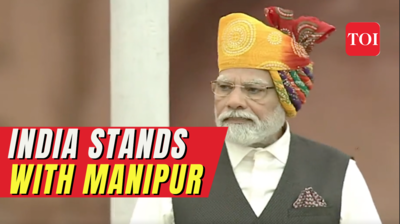
By P. Sudhir
Prime Minister Narendra Modi’s Red Fort speech on the occasion of the 77th Independence Day had all the hallmarks which have become typical of his Independence Day speeches of the past years. There were the boastful claims of how, since 2014, India has made tremendous progress in all fields. The only new addition was Modi’s claim that we can look forward to a thousand years of `Amrit Kaal’ as compared to the thousand years of slavery which began with Muslim rule and ended with British rule. There was, as usual, a long litany of achievements of the government in different spheres with the focus firmly being on the central role of Modi himself.
It would be a waste of time to critically pull apart the bombastic claims and bring them face to face with the actual realities. Such critical examinations have been done in the past and now too. Instead, it would be more useful to look at the political aspects of his speech.
Modi touched upon the Manipur situation right at the beginning of his speech. But what he said would have disappointed the people of Manipur and all concerned citizens in the country. He superficially talked of how there was conflict, lives were lost and women dishonoured, but that peace had returned to the state in the last few days. He said that the central and state governments are working together to establish peace and solve the problems. The message was clear. The chief minister, Biren Singh, who was responsible for aggravating the ethnic conflict and playing a partisan role, is not to be held accountable. In fact, the central government is going to depend on him to find political solutions. There was nothing about rendering justice to the victims of the horrible sexual crimes, nor was there any reflection on how this sensitive north-eastern state was plunged into ethnic conflict and chaos.
The politics in the speech was obviously coloured by the forthcoming 2024 elections. The speech saw a sharp attack on the opposition, unlike earlier Independence Day speeches. He attacked dynastic politics, corruption and appeasement politics (tushtikaran). Referring to his pet theme, he said that dynasty parties are a “disease” and “deformity” in Indian democracy. However, this tirade against dynastic politics ignores the fact that within the BJP, more and more political dynasts are assuming key positions at the state and national levels.
As for his harangue against corruption, it has become another potent weapon against the opposition parties. The Enforcement Directorate has been weaponised to crackdown on opposition leaders. That corruption is purely a weapon against the opposition is amply clear when we see the record of high level corruption in the past nine years and how the Modi government has tackled it. Apart from burying the glaring discrepancies in the Rafale deal, the latest CAG report has exposed wide ranging corruption in the building of highways and in the implementation of various central government schemes like the PM-JAY.
It is the attack on the politics of “appeasement”, which is new and ominous in the Independence Day speech. Appeasement means minority appeasement. According to Modi, this appeasement has put a blot on national character and harmed social justice. Modi was condemning minority appeasement from the ramparts of the Red Fort, just 70 kilometres away from Nuh where there was widespread communal violence only a few days ago, in which the Meo Muslims bore the brunt of attacks by the Hindutva goons and were targeted by the state administration. For Modi, to decry minority appeasement at a time when Muslim homes and shops were bulldozed by the administration, is a clear signal that communal polarisation will be on the agenda for escalation in the run-up to the Lok Sabha polls.
All in all, the tenth Independence Day speech of Narendra Modi was a display of the toxic politics of the BJP-RSS combine. (IPA Service)
The post Narendra Modi’s Tenth Independence Day Speech Was A Display Of Toxic Politics first appeared on Latest India news, analysis and reports on IPA Newspack.


